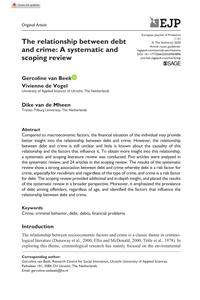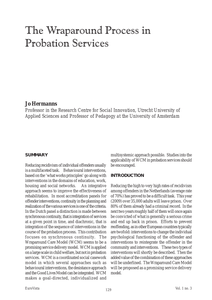A workshop that took place on the conference "The Restoration of Normality – Mirroring the Past in the Future" with the themes (among others) domestic violence, restorative justice, social support for ex-offenders, education & training and building up a probation service.
DOCUMENT

The relationship between socioeconomic factors and crime is a classic theme in criminological literature. However, the relationship between debt and crime is still unclear, and little is known about the causality of this relationship and the factors that influence it. In addition, effective interventions and guidelines to adequately support offenders with debt are limited. Therefore, this thesis aims to systematically gain more insight into the factors that influence the relationship between debt and crime among probation clients and to contribute to developing tools that probation officers and other forensic social professionals can use to support clients with debt adequately. The relationship between debt and crime was studied by (1) a systematic and scoping literature review (5 studies were included in the systematic review and 24 studies in the scoping review), (2) a client file study including risk assessment data of a sample of 250 Dutch probation clients, (3) a quantitative study including recidivism data of the same sample of 250 Dutch probation clients, (4) interviews with 33 Dutch probation officers and 16 clients, and (5) a multiple case study focusing on working elements in the supervision of individual offenders (5 cases). The results show that debt is prevalent among probation clients, hinders resocialization, and increases recidivism risk. Debt and crime are not only related directly but are also related by a complex interplay of problems in different life domains, such as problems regarding childhood, education and work, and mental and physical health. Notwithstanding the strong relationship between debt and crime, financial assistance for probation clients with debts is limited. As debt is strongly related to problems in other life domains, a systematic collaboration between professionals of different disciplines is necessary to support clients with debt adequately.
DOCUMENT

Compared to macroeconomic factors, the financial situation of the individual may provide better insight into the relationship between debt and crime. However, the relationship between debt and crime is still unclear and little is known about the causality of this relationship and the factors that influence it. To obtain more insight into this relationship, a systematic and scoping literature review was conducted. Five articles were analyzed in the systematic review, and 24 articles in the scoping review. The results of the systematic review show a strong association between debt and crime whereby debt is a risk factor for crime, especially for recidivism and regardless of the type of crime, and crime is a risk factor for debt. The scoping review provided additional and in-depth insight, and placed the results of the systematic review in a broader perspective. Moreover, it emphasized the prevalence of debt among offenders, regardless of age, and identified the factors that influence the relationship between debt and crime.
DOCUMENT

Victim-offender contact has been studied extensively in prisons, but research on contact between victims and mentally disordered offenders in forensic mental health settings is lacking. Therefore, an exploratory study was conducted on contact between victims and offenders in four Dutch forensic psychiatric hospitals. These offenders have committed serious (sexually) violent offenses, for which they could not be held fully responsible due to severe psychopathology. During the mandatory treatment, it is possible for offenders and their victims to engage in contact with each other if both parties agree to this. To explore the conditions under which this contact is suitable, we interviewed 35 social workers about their experiences in 57 cases from four Dutch forensic psychiatric hospitals. Findings demonstrated that, according to the social workers, no type of offense or psychopathology were obvious exclusion criteria for victim-offender contact. Social workers described offenders' problem awareness, stable psychiatric condition, and ability to keep to agreements as important factors that enable victim-offender contact. Implications and suggestions for future research are provided.
DOCUMENT

Hoofdstuk 20 Part II in Understanding Penal Practice van Ioan Durnescu en Fergus McNeill Criminological and penological scholarship has in recent years explored how and why institutions and systems of punishment change – and how and why these changes differ in different contexts. Important though these analyses are, this book focuses not so much on the changing nature of institutions and systems, but rather the changing nature of penal practice and practitioners The first part of the book focuses on understanding practice and practitioners, exploring how changing social, cultural, political, and organisational contexts influence practice, and how training, development, professional socialisation and other factors influence practitioners. The second part is concerned with how practitioners can be best supported to develop the skills and approaches that seem most likely to generate positive impacts. It contains accounts of new practice models and approaches, as well as reports of research projects seeking both to discover and to encourage effective practices
MULTIFILE

Reducing recidivism of individual offenders usually is a multifaceted task. Behavioural interventions, based on the ‘what works principles’ go along with interventions in the domains of education, work, housing and social networks. An integrative approach seems to improve the effectiveness of rehabilitation. In most accreditation panels for offender interventions, continuity in the planning and realization of the various services is one of the criteria. In the Dutch panel a distinction is made between synchronous continuity, that is integration of services at a given point in time, and diachronic, that is integration of the sequence of interventions in the course of the probation process. This contribution focuses on synchronous continuity.
DOCUMENT

Review in het kader van COST Action IS1106 Working group 3 In the review below, we summarize resent empirical research about practising offender supervision in The Netherlands on six theme’s: 1. The roles, characteristics, recruitment and training of key actors in the delivery of offender supervision. 2. Interactions and relationships between key actors in the delivery of offender supervision and other relevant professionals. 3. The delivery/practice/performance of offender supervision. 4. The role of tools and technologies in the delivery of OS. 5. The management, supervision and/or regulation of practitioners and their practice. 6. Reflections / contextual issues Ongoing research is discussed in the descriptions of the different theme’s. We conclude with a short reflection about research on practising supervision in the Netherlands. The review is limited to studies about adults. Studies on community sentences have not yet been addressed, we will do this in the next version.
DOCUMENT

Women and girls represent only a minority in the penitentiary system and in forensic mental health care. About 6%–10% of both prison and forensic psychiatric populations in Western countries comprise women (see for the most recent offi cial statistics in the UK w ww.gov. uk/government, in Canada w ww.statcan.gc.ca, and in the US w ww.bjs.gov) . However, there seems to be widespread agreement that in the past 20 years female offending has been on the rise, especially violent offending and particularly among young women ( Miller, Malone, and Dodge, 2010; M oretti, Catchpole, and Odgers, 2005) . Overall, a disproportionate growth of females entering the criminal justice system and forensic mental health care has been observed in many countries (for reviews, see Nicholls, Cruise, Greig, and Hinz, 2015; Odgers, Moretti, and Reppucci, 2005 ; Walmsley, 2015) . In addition, it should be noted that the ‘dark number’ for women is suggested to be bigger than for men. Offi cial prevalence rates of female offending might constitute an underestimation as women usually commit less reported offences, for example, domestic violence (N icholls, Greaves, Greig, and Moretti, 2015) . Furthermore, it has been found that – if apprehended – girls and women are treated more leniently by professionals and the criminal justice system. Generally, they receive lower prison sentences and are more often admitted to civil psychiatric institutions instead of receiving a prison sentence or mandatory forensic treatment after committing violence ( Javdani, Sadeh, and Verona, 2011 ; Jeffries, Fletcher, and Newbold, 2003 ). Hence, although female offenders compared to male offenders are a minority, female violence is a substantial problem that deserves more attention. Our understanding of female offenders is hindered by the general paucity of theoretical and empirical investigations of this population. In order to improve current treatment and assessment practices, our knowledge and understanding of female offenders should be enlarged and optimised (d e Vogel and Nicholls, 2016 ).
DOCUMENT

This article draws on Robinson, McNeill and Maruna’s argument (2012) about the adaptability of community sanctions and measures, observed through four distinctive penal narratives, in order to shed light on the regional development of community service in Wroclaw, Poland. While the managerial adaptation of community sanctions is underpinned by an inter-agency cooperation to fulfil the goals of the system, the contemporary rehabilitation iteration has become a toolkit of measures predominantly phrased around risk management, the reparative discourse seeks various means to repair harm, and the punitive orientation represent the turn to desert-based and populist sentencing frameworks. In this article, the first three are reflected upon along with the emerging, restorative adaptation of community sanctions. The last one is added to expand on the findings of previous research, which suggests the viability of the restorative orientation for community service in Poland (Matczak, 2018). A brief discussion of how punishment, probation and restorative justice can be reconciled is followed by the introduction of Polish Probation and the role of probation officers in delivering community service in Poland. Although the penal narratives are visible in the Wrocław model to different degrees and in various combinations, more research is required to evaluate the viability of a progressive orientation to punishment during a gradual optimisation of community orders. Originally published: Anna Matczak, The penal narratives of community sentence and the role of probation: The case of the Wrocław model of community service, European journal of probation (Vol. 13 nr. 1) pp. 72-88. Copyright © 2021year (The Author). DOI: 10.1177/2066220320976105
MULTIFILE

The past two decades, a disproportionate growth of females entering the criminal justice system and forensic mental health services has been observed worldwide. However, there is a lack of knowledge on the background of women who are convicted for violent offenses. What is their criminal history, what are their motives for offending and in which way do they differ from men convicted for violent offenses? In this study, criminal histories and the offenses for which they were admitted to forensic care were analyzed of 218 women and 218 men who have been treated between 1984 and 2014 with a mandatory treatment order in one of four Dutch forensic psychiatric settings admitting both men and women. It is concluded that there are important differences in violent offending between male and female patients. Most importantly, female violence was more often directed towards their close environment, like their children, and driven by relational frustration. Furthermore, female patients received lower punishments compared to male patients and were more often considered to be diminished accountable for their offenses due to a mental illness.
MULTIFILE
